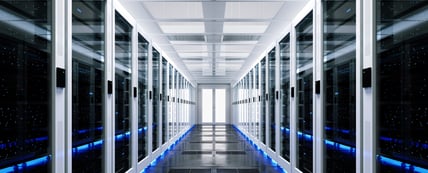 (This blog post from John Hewitt, president of Vertiv, offers insight into one of the greatest trends of 2020 - hybrid computing. Check it out! -Teddi)
(This blog post from John Hewitt, president of Vertiv, offers insight into one of the greatest trends of 2020 - hybrid computing. Check it out! -Teddi)
The introduction of cloud computing triggered a decade-long debate over its implications for traditional enterprise data centers. As the cloud market expanded beyond anyone’s wildest imagination ($227.8 billion in 2019 … and still growing), experts across the industry questioned the future of enterprise facilities. Eventually, many argued, everything would be housed in the cloud.
And yet here we are, in the early days of 2020 – some 14 years since Schmidt uttered the term publicly for the first time – and even in the face of jaw-dropping cloud growth, enterprise data centers are alive and well. In fact, today’s enterprise remains critical to most network architectures and more and more is acting as the hub for emerging hybrid architectures that incorporate public and private cloud models and mission-critical edge assets. This evolving approach to managing data and IT resources is one of the leading data center trends to watch this year.
Of course, cloud computing will continue to be an important part of most IT strategies, but organizations are rejecting the either/or nature of the enterprise/cloud debate. Going forward, many will seek to tailor their IT mix and spending to the needs of their applications, with the role of the enterprise data center changing to reflect a mix that best serves modern businesses.
Vertiv polled experts from across its organization, around the world, to compile a list of five trends expected to impact the data center in 2020. These hybrid architectures topped the list, although our experts were in alignment with several other emerging trends.
Speed of deployment as the new arms race. As the differences in capabilities across technologies and systems become more difficult to discern, other factors will contribute to equipment selection. Cost always matters, of course, but even on that front, differences can be relatively small and open to interpretation based on performance and total cost of ownership. With that in mind, purchasing decisions increasingly will depend on how quickly assets can be deployed. When all other factors are close, any advantage in speed of deployment and activation can be the determining factor. The speed advantage is especially visible as computing continues to migrate to the edge in today’s distributed networks, where delivery delays mean lack of service – and revenue.
Average rack density remains static, but… Average rack density has remained relatively stable for a decade or more and is unlikely to change anytime soon. However, the advanced applications and workloads associated with artificial intelligence will make pockets of high-performance, high-density computing necessary and more common. Early activity in this space is most likely in the areas of defense, advanced analytics and manufacturing, laying the foundation for more widespread adoption in 2021 and beyond. Even though these racks represent a tiny percentage of total deployments, they nevertheless present unfamiliar power and cooling challenges for decision-makers in those facilities. The increasing interest in direct liquid cooling is a response to these kinds of high-performance computing demands.
Batteries pay it forward. As early as 2016, Vertiv experts predicted lithium-ion batteries would begin to find a home in the data center. That prediction has proven to be accurate, as lithium-ion holds a significant share of today’s UPS battery market. Adoption of lithium-ion is extending to edge sites, where the smaller footprint and reduced maintenance requirements make obvious sense. As lithium-ion deployments increase, organizations are starting to explore ways to leverage the flexibility of these and other battery alternatives to offset their costs. Our experts expect more organizations will start to sell the stored energy in these batteries back to the utility to help with grid stabilization and peak shaving.
Global cross-pollination. While the U.S., particularly Silicon Valley, has been Ground Zero for the data explosion of the last two decades, data center innovation is not exclusively an American exercise. A parallel but distinctive digital ecosystem is emerging in China, and data centers across Europe and in other Asian and South Pacific markets, such as Australia, New Zealand and Singapore, are evolving and diverging based on their regional activities and considerations. Issues like data privacy and sustainability are leading to new thinking about hybrid architectures and the value of on-premise computing and data storage. In some cases, the differences can be fundamental and dramatic. In China, for example, some data centers have been running 240V DC power into manufacturer-modified servers to improve efficiency and reduce costs. As these types of innovations become more established regionally, it’s easy to envision other parts of the world following suit.
If there is a theme across these trends, it may be the pursuit of slight advantages and differentiators across the data center and around the world. Organizations are looking for ways to optimize their networks and data management, deploy equipment faster, and reduce costs. Even small advantages can be significant in an increasingly competitive, global data economy. At Vertiv, we are committed to pursuing and providing those advantages anywhere we can.
Click here to contact your local Accu-Tech representative and learn more about Vertiv.


.png?width=58&height=58&name=X_logo_2023_(white).png)
